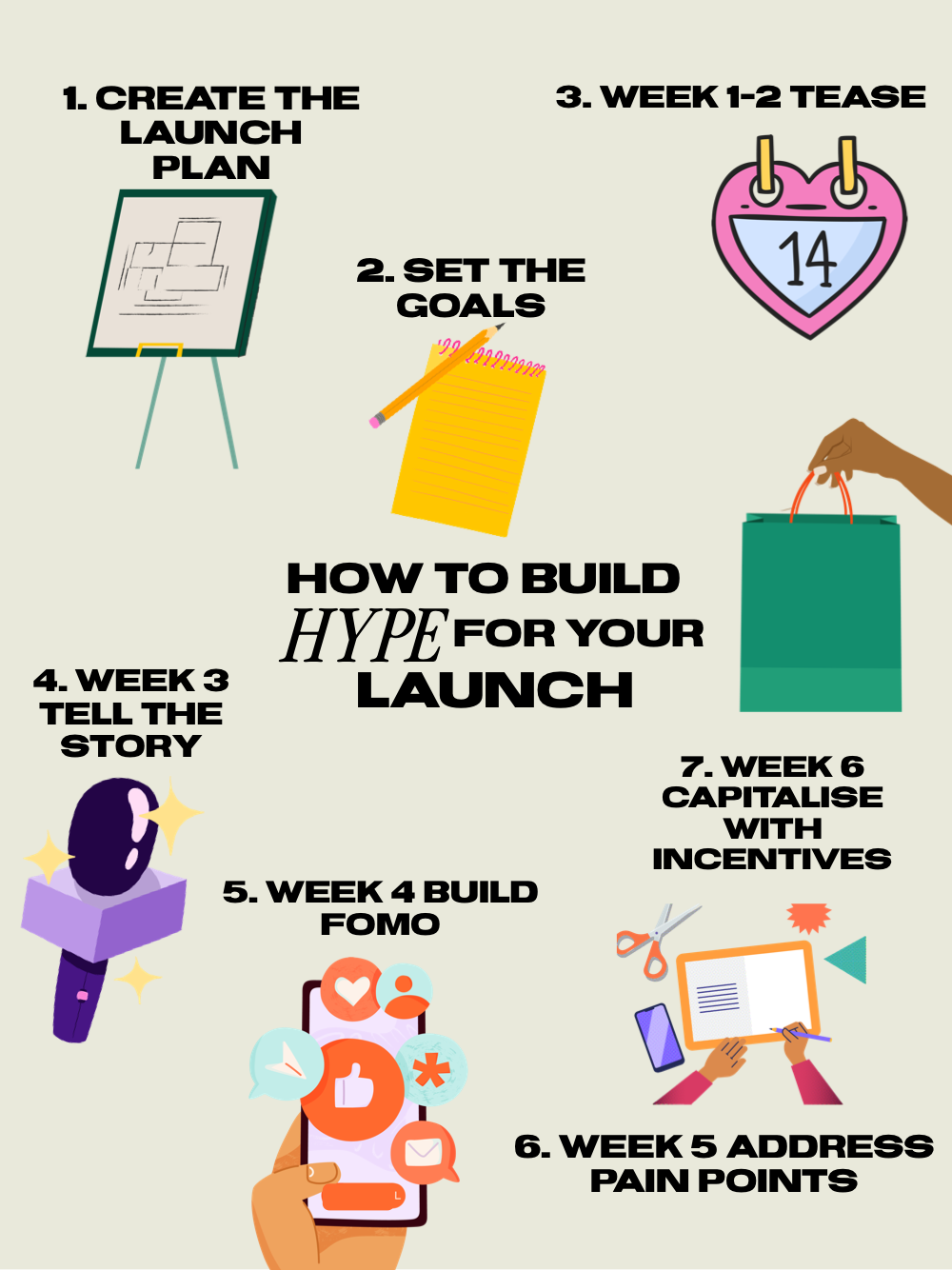I asked 1000 founders what they struggle with the most when it comes to marketing their business successfully. Launch strategy came in the top 3 results and this has prompted me to created this blog for you - the ambitious small business owner.
When I say i've MASTERED launch strategy, it mean it. Here’s a glimpse into the results from my last three launch days:
March: £12,169 on launch day
May: £10,687 on launch day
June: £5,689 on a restock launch (yes, a restock—not even a new product!)
You might be wondering how I achieve these impressive numbers consistently. The secret lies in seven key steps that I follow religiously for every launch. Let's dive into each one, complete with real-life examples and statistical insights that underscore their effectiveness. Launch strategy made easy in 3,2,1...

1. Plan Your Launch Strategy Over 6 Weeks
Effective planning is the backbone of any successful launch. You meticulously outline every detail, from the marketing campaign to the customer journey, ensuring everything is aligned with your goals. This involves creating a comprehensive timeline, scheduling key activities, and assigning responsibilities. For example, during my March launch, I spent the first week brainstorming content ideas and the next week developing those ideas into a cohesive plan. By the time launch time arrived, I had a clear roadmap to follow, which eliminated stress and allowed me to execute flawlessly.
Stat Insight: According to a study by CoSchedule, marketers who document their strategy are 313% more likely to report success. This statistic emphasizes the importance of having a detailed plan in place.
2. Set Your Goals
Setting clear, measurable goals is absolutely crucial. You establish targets for the number of people joining the waitlist, launch day sales, and launch week sales. This helps you stay focused and measure success accurately. For instance, for my May launch, I set a goal of 500 waitlist sign-ups, £10,000 in launch day sales, and £15,000 in launch week sales. By having these targets, I could adjust your strategies in real-time to ensure I stayed on track.

Real-Life Example: For my March launch, the goal was to achieve at least £10,000 within the firsr 24 hours. By focusing on waitlists, story telling and excellent email marketing, I surpassed this goal, reaching £12,169 on launch day.
Stat Insight: According to HubSpot, companies that set specific sales goals experience a 33% increase in sales performance.
3. Tease Early On
Creating anticipation is key. You start teasing your launch early, even before the official six-week countdown begins. Utilizing Instagram stories, where your most engaged audience resides, you drop hints and build excitement gradually. For example, two months before my March launch, I began sharing behind-the-scenes content of the product development process. This not only piqued interest but also fostered a sense of involvement among my audience.
Real-Life Example: Odd Muse London capitolise on their launches by teasing new collections and then asking their audience to join the waitlist for first dibs. Founder Aimee has stated this strategy of tease, waitlist and pre orders has grown their revenue to over £12m last year.
Stat Insight: A report by Sprout Social indicates that social media teasers can increase engagement by up to 100%, highlighting the effectiveness of early promotion
4. Tell the Story
Storytelling is a powerful marketing strategy. You share the inspiration behind the launch, the problems you aim to solve, and the journey leading up to the product's creation. This emotional connection resonates deeply with your audience. For my March launch, I shared the story of how the idea came about during a personal experience where I identified a gap in the market. This narrative not only made my audience relate to the product but also created an emotional bond.
Real-Life Example: During my June restock launch, I recounted customer testimonials and success stories from the initial launch. This reinforced the product’s value and created a sense of community among my customers.
Stat Insight: According to Headstream, 55% of consumers are more likely to buy from a brand if they love the brand story.
5. Build FOMO
A waitlist is essential for every launch. It creates a sense of exclusivity and urgency, making people feel they must act quickly to be part of something special. This psychological tactic heightens excitement and drives conversions. For my May launch, I created a dedicated waitlist page and incentivised sign-ups with early access and exclusive discounts.
Real-Life Example: For my June restock, the waitlist alone accounted for 60% of the launch day sales. This demonstrates the power of creating urgency and exclusivity through a waitlist.
Stat Insight: Research by LinkedIn shows that scarcity can increase perceived value, with products in limited supply appearing up to 50% more desirable.
6. Address Pain Points
Eliminating doubts is crucial. You ensure your audience knows exactly why they need your product, how much it costs, and what benefits it offers. Addressing these questions through your content strategy and email marketing ensures a smoother launch. For my March launch, I dedicated a week to creating content that answered common questions and highlighted the unique benefits of the product.
Real-Life Example: During my May launch, I conducted a live Q&A session to address any lingering doubts my audience had. This not only cleared up confusion but also built trust and credibility.
Stat Insight: According to a report by Econsultancy, 61% of customers read online reviews before making a purchase decision, emphasizing the need to address all potential concerns proactively.
7. Capitalize by Using Incentives
Incentives are a great way to boost launch day orders. Offering perks like "the first 20 orders receive a freebie" can significantly drive sales and encourage early purchases. For my June restock, I gave waitlist members one hour early access to shop. This not only spurred immediate sales but also created additional buzz around the launch.
Real-Life Example: For my March launch, I provided a bundle discount code which led to a rapid surge in sales and increased the average order value.
Stat Insight: A study by Shopify found that limited-time offers and incentives can increase conversion rates by up to 30%.
Mastering a launch strategy involves meticulous planning, setting clear goals, creating anticipation, telling a compelling story, building FOMO, addressing pain points, and capitalizing on incentives. These steps, backed by real-life examples and statistical insights, form the foundation of a successful launch strategy.
Interactive Launch Guide
If you're eager to replicate this success and want a step-by-step interactive launch guide that covers everything—from planning to setting goals, crafting the perfect messages, timing your emails, and more—then you’ll be thrilled to know your waitlist is open!
Join now and be the first to access your comprehensive launch guide, coming at the end of August. Don't miss out on this opportunity to transform your launches and achieve outstanding results.
INTRODUCTORY OFFER FOR ANYONE ON THE WAITLIST - SAVE £10




